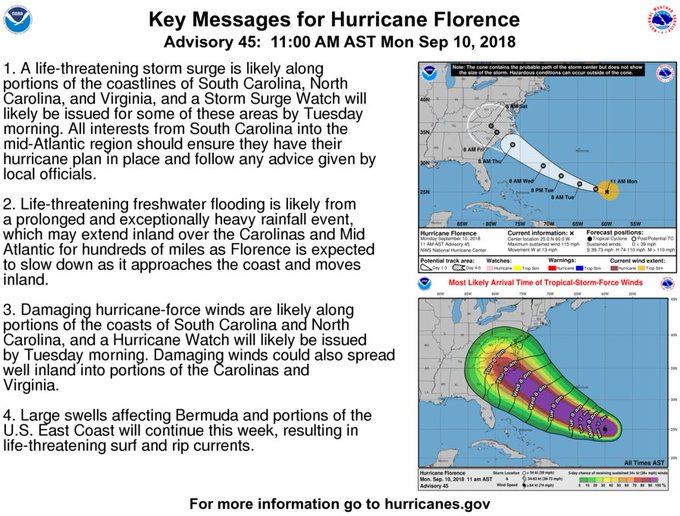President Donald Trump late Monday approved an emergency declaration for North Carolina as ‘life-threatening’ Hurricane Florence barrels toward the Carolinas and is expected to strengthen to a Category 5 storm.
The president’s action authorizes the Department of Homeland Security and FEMA to coordinate disaster relief efforts for “the hardship and suffering caused by the emergency on the local population,” a White House statement said, according to South Carolina’s The State.
State and local officials in the Carolinas and Virginia have ordered around 1.5 million people to evacuate, The Washington Post reported.
The hurricane had sustained winds of 140 mph and remained a Category 4 storm Monday. Scientists warn, however, that the unusually warm water could accelerate the storm’s winds to 155 mph — nearly Category 5 intensity, The Post reported.
Florence is expected to make landfall on Thursday and could become one of the most catastrophic hurricanes to hit the Eastern Seaboard in decades.
“Life-threatening freshwater flooding is likely from a prolonged and exceptionally heavy rainfall event,” the National Weather Service said in an advisory.
The hurricane is also forecast to hit a stretch of coastline that’s vulnerable to rising sea levels due to climate change, according to the Associated Press.
“Life-threatening freshwater flooding is likely from a prolonged and exceptionally heavy rainfall event.”
South Carolina Gov. Henry McMaster ordered the state’s entire coastline to be evacuated starting at noon Tuesday and predicted that 1 million people would flee.
Virginia Gov. Ralph Northam issued an evacuation order that applies to about 245,000 people.
North Carolina Gov. Roy Cooper said his state was “in the bullseye” of the storm and urged people to “get ready now.”

This photo provided by NASA shows Hurricane Florence from the International Space Station on Monday, as it threatens the U.S. East Coast. (NASA via AP)
Maryland Gov. Larry Hogan also declared a state of emergency, as officials “are preparing for any possible outcome, including the potential of historic, catastrophic, and life-threatening flooding in Maryland.”
Several meteorologists said Florence could do what Hurricane Harvey did last year over Texas, dumping days of rain, although not likely not as bad.
“I think this is very Harvey-esque,” said Brian McNoldy, University of Miami hurricane expert. “Normally, a landfalling tropical cyclone just keeps on going inland, gradually dissipating and raining itself out. But on rare occasions, the steering patterns can line up such that a storm slips into a dead zone between troughs and ridges.”
“I think this is very Harvey-esque.”
The Associated Press contributed to this report
This article was put together by our C-VINE team of volunteer investigative, citizen journalists who make certain all information is vetted for accuracy before publishing. C-VINE News is run by, “We the People”.
Conversations and discussions are being held on the C-VINE News Talk – Facebook Group Page. (Must be a Facebook member): C-VINE News Talk


